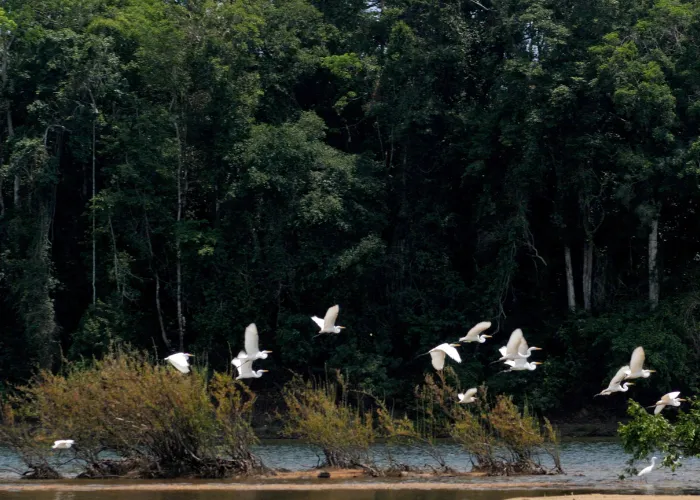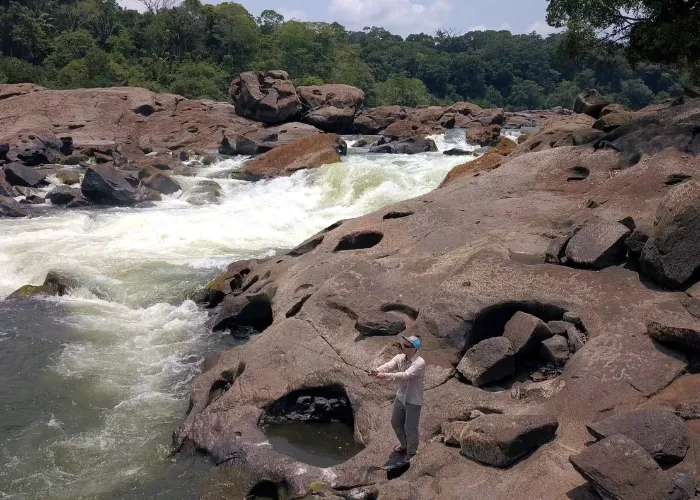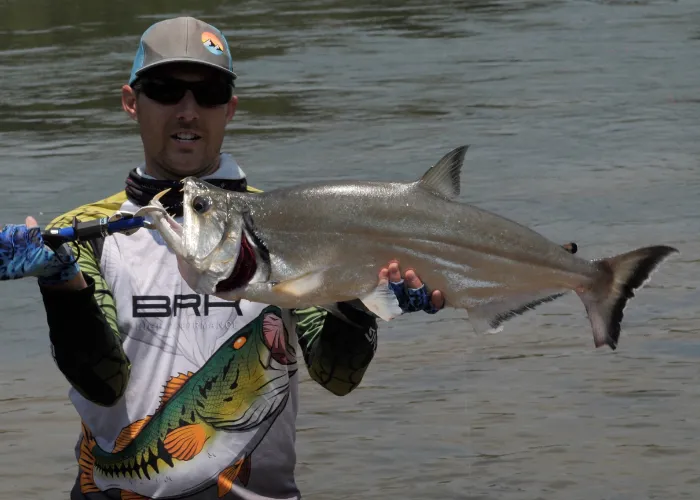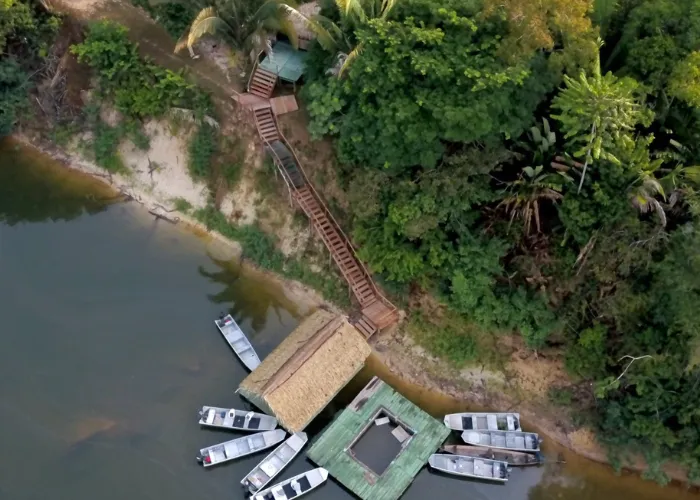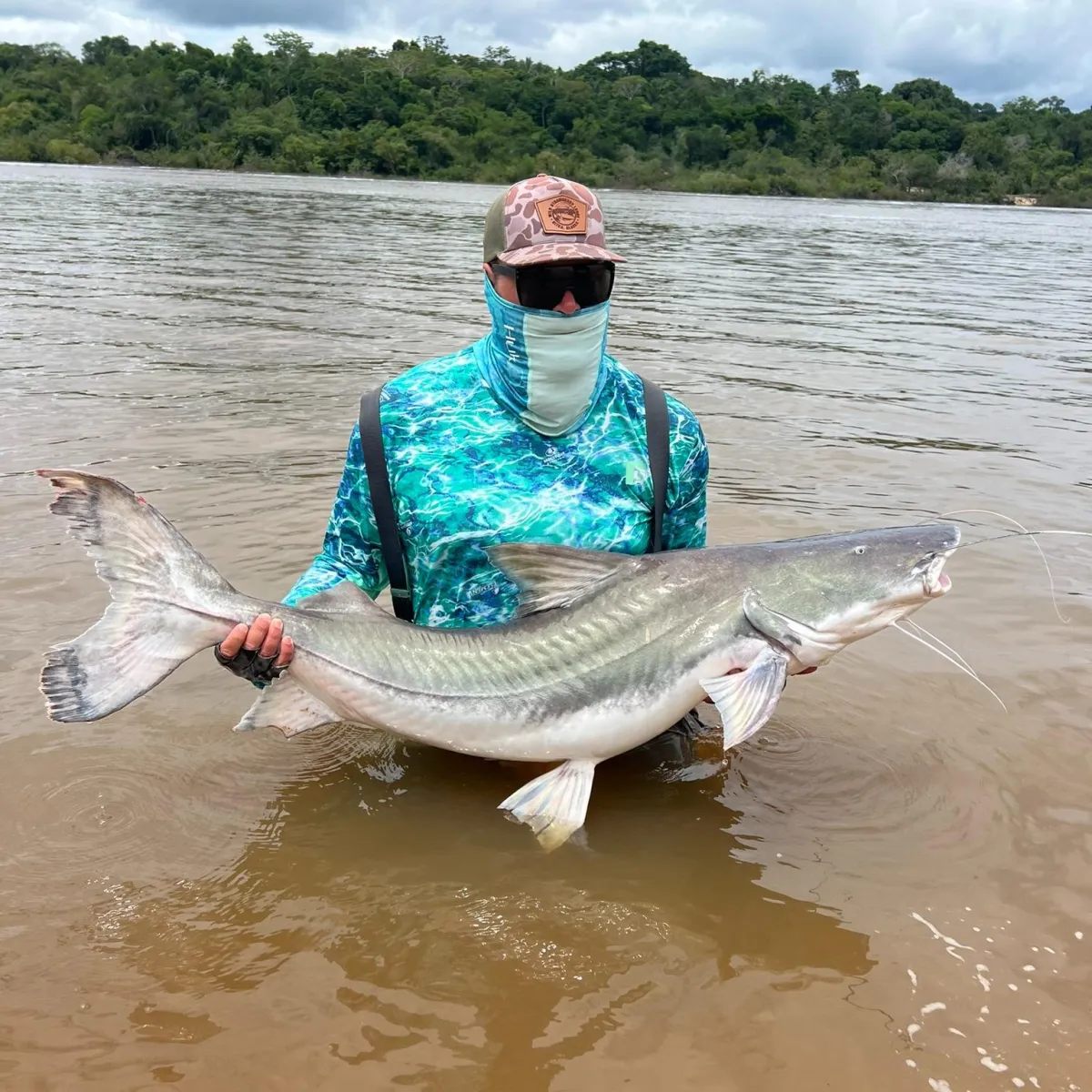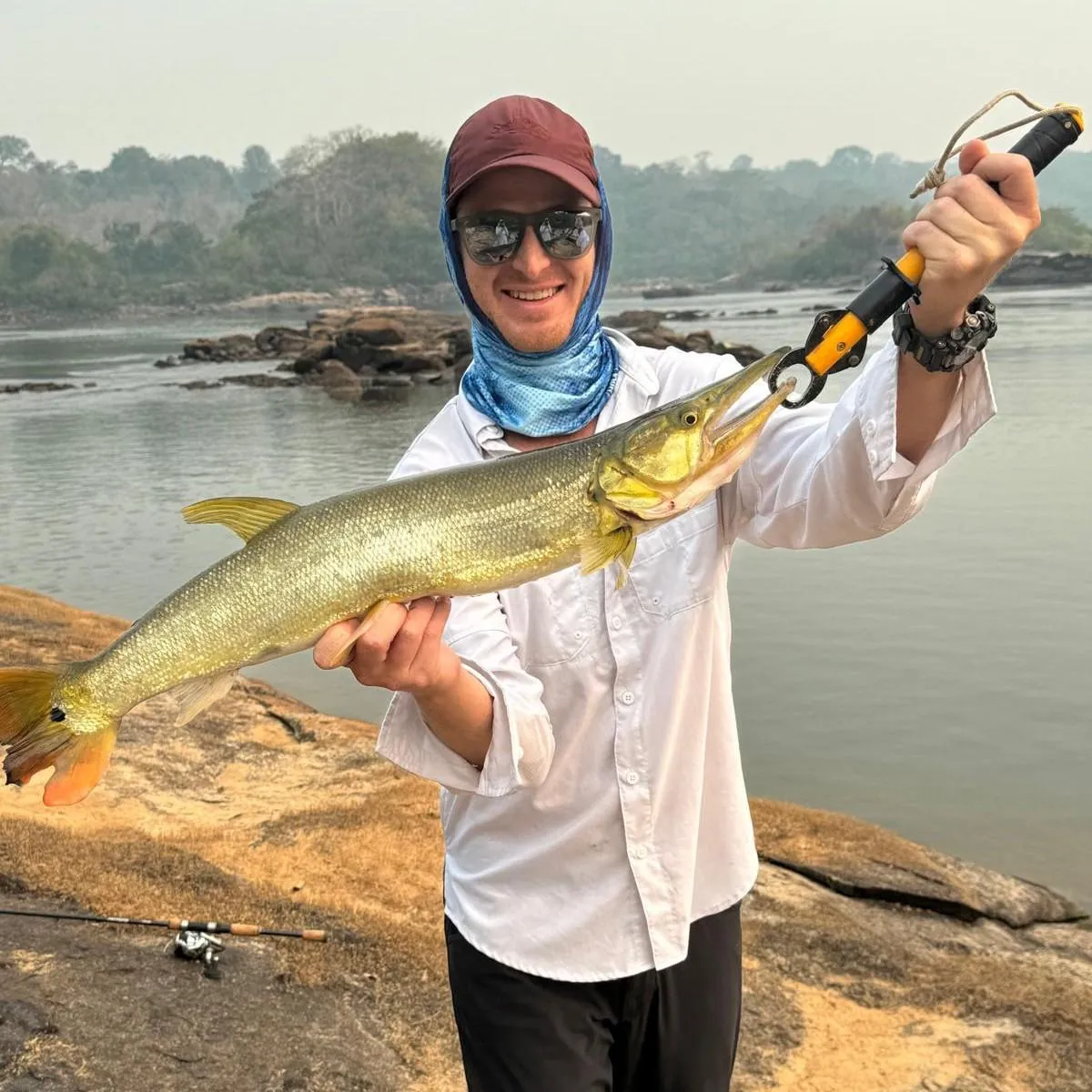Multi-Species Amazon Fishing Adventures
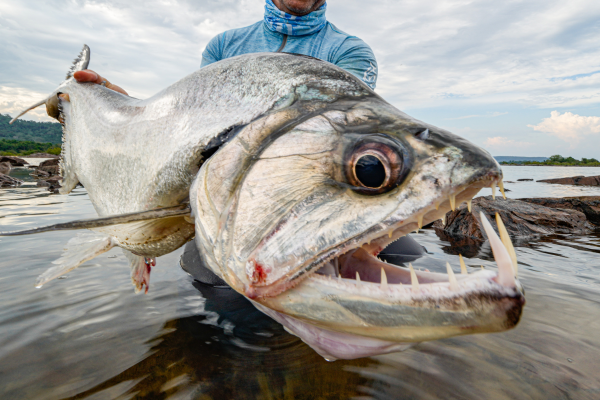
Not all Amazon fishing trips are about peacock bass. Some are about something broader—something wilder. Acute Angling’s multi-species expeditions open the door to a different kind of Amazon experience: one that blends intense fishing action with a deep immersion into the jungle itself. These trips focus on a variety of powerful predators, including the fierce payara, massive Amazon catfish, sharp-toothed black piranha, and other exciting species like wolfish, bicuda, and matrinxã. It’s fishing at its most unpredictable—and most exciting.
At the center of it all is the payara, a razor-fanged predator that strikes with shocking speed and puts up aerial battles that test even the most experienced anglers. Beneath the surface, enormous redtail catfish, jau, and elusive piraíba haunt the river bottom, offering deep, grinding fights that demand strength, patience, and endurance. Between these giants, the river remains alive with aggressive secondary species, providing action from the first cast to the last.
Payara & Multi-Species Focused Trips
Rio Aripuana
Variety, Action, and Jungle Beauty
This remote river delivers a high-action mix of payara, giant catfish, bicuda, Pinima peacock bass, and other species, in a setting that's both pristine and productive. Anglers stay in a comfortable jungle lodge with air-conditioned cabanas and enjoy six full days of non-stop fishing in rich, protected waters.
XINGU RIVER
Remote Fishing with Cultural Connection
Set in the Kayapo indigenous reserve, the Xingu trip blends great multi-species fishing with a chance to engage with one of the Amazon’s native communities. You'll catch payara, giant catfish, Melaniae peacock bass, and more while experiencing an unforgettable cultural exchange in one of the most remote places we go.
What truly sets these trips apart is the setting. You’ll fish in some of the Amazon’s most untouched and remote regions—where the jungle hums with life and every day brings incredible encounters. Monkeys call from the treetops, giant river otters slide along the banks, and macaws, toucans, and capybaras are common sights. Lucky anglers might even spot a tapir crossing a sandbar—or catch a glimpse of a jaguar in the early morning light. These trips don’t just feel like the Amazon—they are the Amazon, in all its raw beauty and intensity.
Our multi-species trips are timed to maximize the opportunities of catching the biggest variety in fish species. With expert guides, comfortable accommodations, and seamless logistics, you’ll be in the right place at the right time—ready to experience the jungle’s fiercest fishing in an atmosphere that’s both wild and welcoming.
TESTIMONIALS
What others are saying
“This experience was way beyond my expectations! I would recommend it to everyone that likes fishing. All of the staff were just incredible and took excellent care of us.”
- Mark S.

“Great trip! Fun atmosphere, wonderful food, and very comfortable accommodations. We caught 15 different types of fish and had a blast.”
- Travis W.

“Multi-species trip was extraordinary.”
- Dawn S.

“My father and I caught over 13 different species of fish! Total slam dunk”
- James S.

“Trip of a lifetime! Don't hesitate!”
- Bret A.

“Peacock Bass has been #1 on my bucket list for a very very long time. It was a trip of a lifetime. The bonus was catching all the other species. Giant Piraiba, Redtails, Piranha, Payara, and Jundia just to name a few. If anyone is thinking about a trip like this you need to look up Acute Angling. You won't be disappointed.”
- Laura S.

Join Us: Get monthly newsletters, discount offers and new content notifications exclusively for our members. Join for FREE below with your name and email.
Join Us: Get monthly newsletters, discount offers and new content notifications exclusively for our members. Join for FREE below with your name and email.
Read Our Newest Blogs
Lorem ipsum dolor sit amet, consectetur adipiscing elit. Aliquam

Amazon Peacock Bass – The Ultimate Peacock Bass Fishing Experience in South America
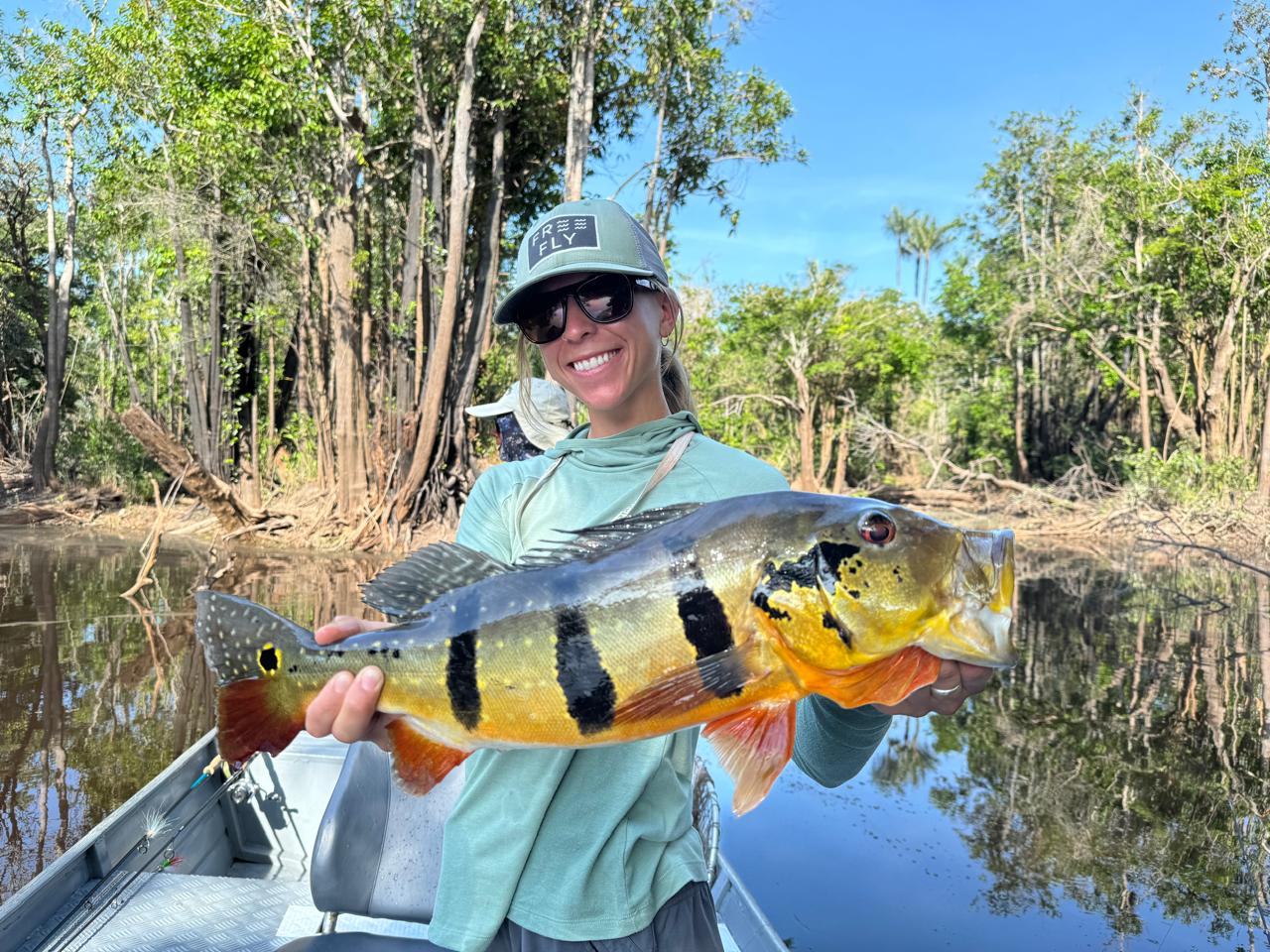
Peacock Bass (Cichla spp.)
Peacock bass is the common name for a group of large, bass-like gamefish native to tropical South America. Despite the name, they are not true bass (like largemouth or smallmouth), but instead belong to the genus Cichla, within the family Cichlidae—a diverse group of tropical fishes found across South America, Africa, Madagascar, and India. Recently, taxonomists reclassified the Cichlid family into a newly formed order, Cichliformes.
These peacock bass species are among the most sought-after sportfish in South America, renowned for their aggressive strikes, raw power, and topwater explosions. All species are temperature-sensitive tropical fish, although smaller varieties have been successfully introduced into subtropical environments from Panama to Hawaii. In the U.S., transplants from Guyana now thrive in freshwater canals across Miami and Dade County, Florida.
Significant variation exists in color and pattern across the different types of peacock bass, and confusion often arises from overlapping local and common names. Until 2006, only five distinct species were formally recognized. A taxonomic revision that year expanded the list to 15, greatly improving angler understanding of peacock bass species and identification. A sixteenth was described in 2019. In Brazil, they are known as tucunaré, while in Spanish-speaking countries, they are commonly called pavón.
With so many variations, it’s no surprise that anglers planning a peacock bass fishing South America trip often spend time learning about the different types of peacock bass they might encounter.
Four Species You’ll Likely Encounter on Our Brazil Peacock Bass Fishing Trips
Giant Peacock Bass – Cichla temensis
Popular Names: Speckled, Three-Barred, Açú, or Paca
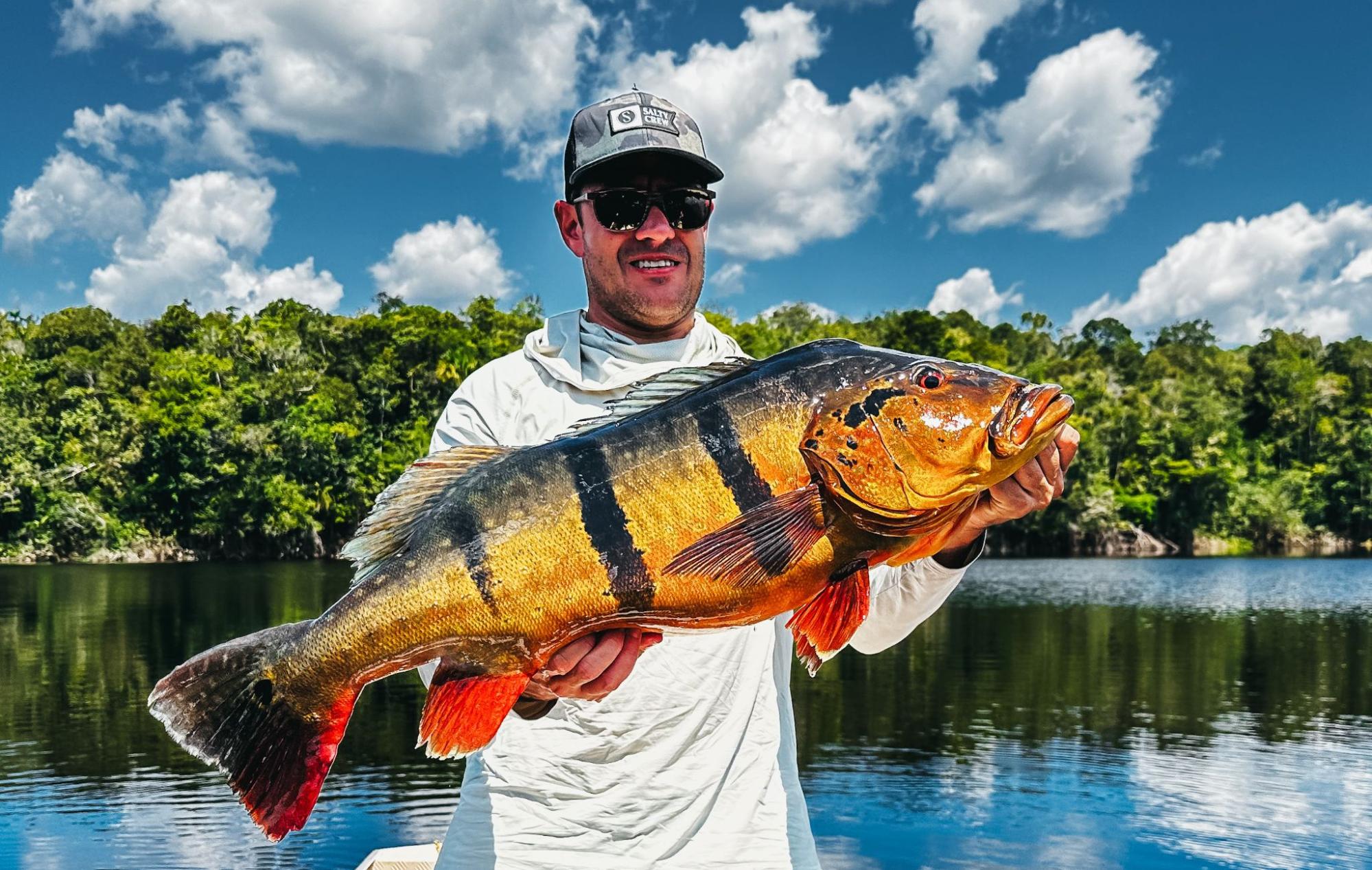
The largest and most coveted of all peacock bass species, Cichla temensis is the centerpiece of our big peacock bass expeditions in the Amazon. These giants can reach sizes exceeding 30 pounds and are the definitive target for anglers chasing a trophy peacock bass.
Like most wild fish populations, larger individuals are less abundant due to natural mortality, predation, and the demands of spawning—creating a population pyramid with fewer fish at the top end of the size scale.
Fish in the 2–7 lb range are most common, while 7–12 lb peacocks are regularly encountered. Fish between 13–19 lbs are less frequent, and true 20+ lb monsters are rare and revered. Landing one puts you among an elite group of anglers who have conquered the biggest peacock bass in the world.

Temensis can be difficult to identify due to its dramatic seasonal color and pattern changes tied to spawning cycles. The three hallmark vertical black bars—typically visible behind the pectoral fin and beneath the dorsal—may fade almost entirely when the temensis isn’t near spawning.
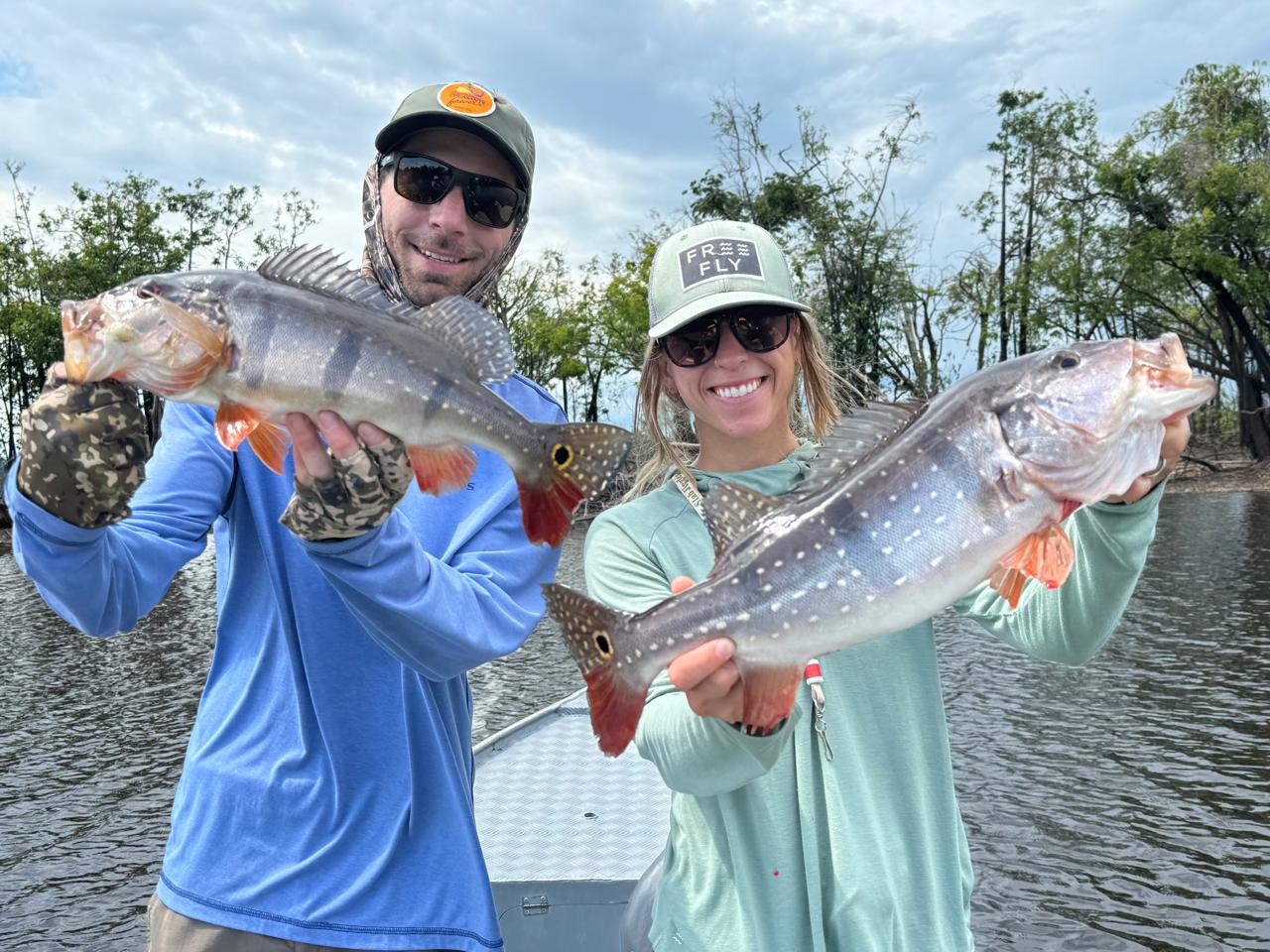
Non-spawning fish display horizontal white speckling across the upper body.
This species has not been widely or reliably established outside the Amazon Basin due to its high sensitivity to temperature fluctuations, though limited success has been noted in isolated controlled environments. It remains the most sought-after peacock bass Amazon trophy.
Butterfly Peacock – Cichla orinocensis
Popular Name: Borboleto
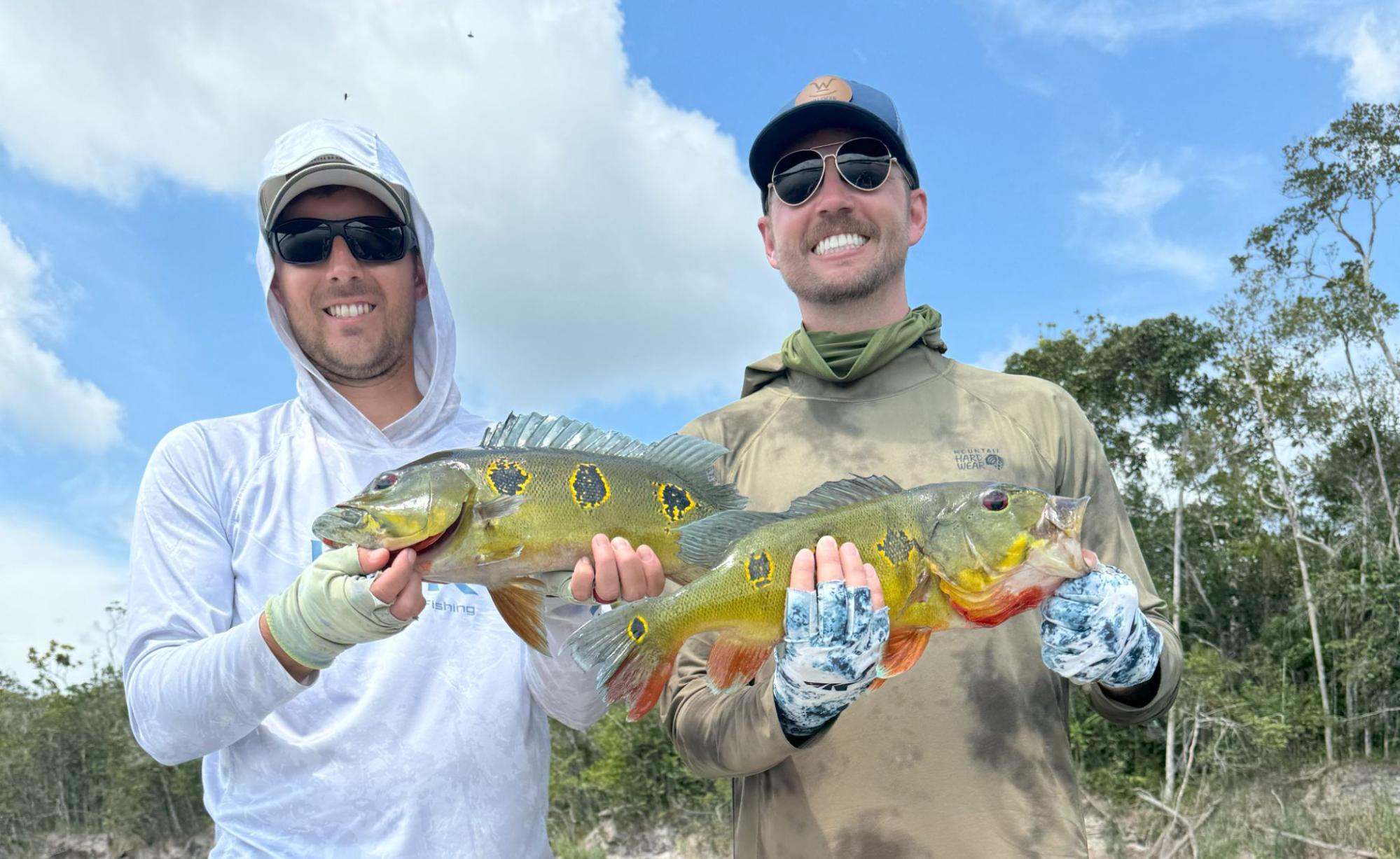
In Brazil, this energetic fighter is called borboleto—Portuguese for “butterfly.” It’s commonly found alongside C. temensis in the Rio Negro basin but prefers shallower, slower-moving waters.
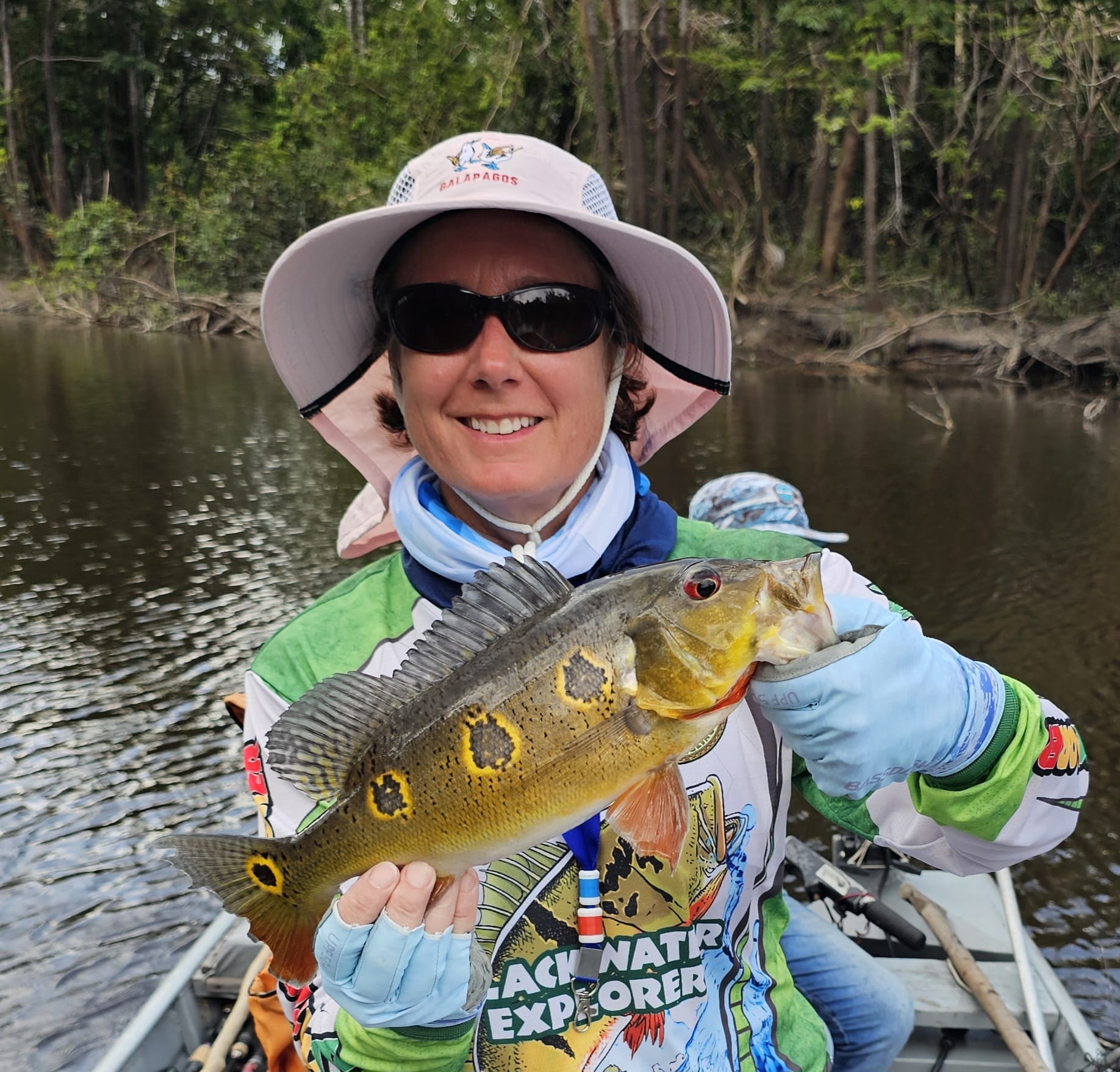
Easily identified by three black ocellated spots (instead of vertical bars), it lacks any opercular markings. Though smaller than its massive cousin, the butterfly peacock is a favorite among both conventional anglers and those fly fishing peacock bass. Most specimens range from 2–8 lbs but butterflies in 10-12 lb range have been caught by our anglers. Their aggression and accessibility make them ideal for first-time Amazon peacock bass fishing anglers seeking action and variety.
Brazil Butterfly Peacock Bass are not the same species as those stocked in Florida Canals.
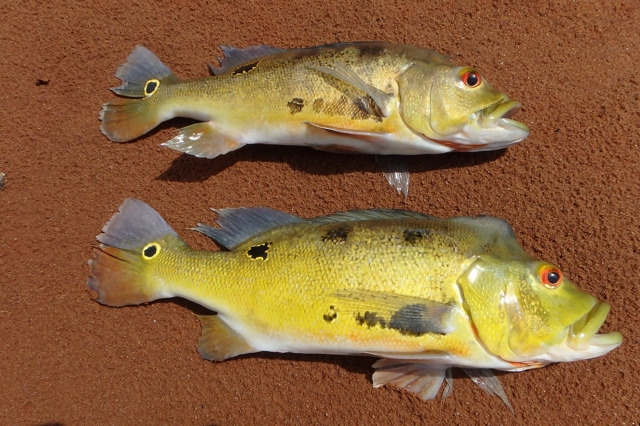
Image taken from: https://www.sciencedirect.com/topics/agricultural-and-biological-sciences/cichla-ocellaris
Note: In Florida, the “butterfly peacock” refers to a different species, Cichla ocellaris, introduced from Guyana. While they are peacock bass, they are very different from Amazon peacock bass. Cichla ocellaris typically features a black ocellus near the pectoral fin in addition to the tail spot and often displays a distinct abdominal bar. Its tolerance for cooler water allowed it to thrive in south Florida, though it is not found in the central Amazon lowlands.
Cichla monoculus
Popular Names: Red-Bellied Peacock, Popoca
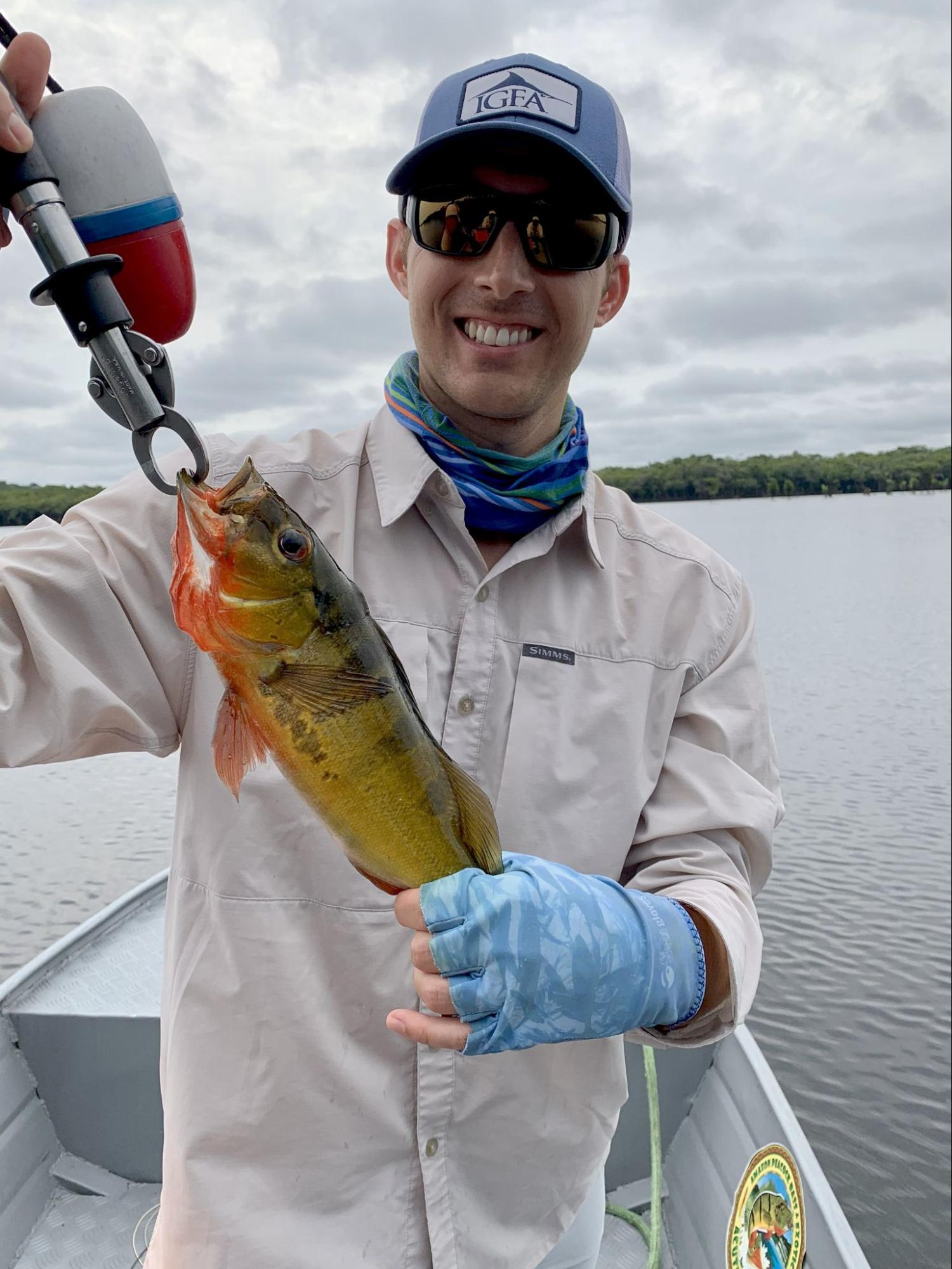
This species can also be caught in the Rio Negro and Maderia river basins. It is recognized by three stubby vertical bars, a blotchy lateral stripe, and a bright red belly—often making it the most vividly colored fish encountered.
C. monoculus typically patrols shoreline structures in search of small prey. Juveniles feed on shrimp, while adults are almost exclusively piscivorous. They generally top out around 5 lbs, though 10-pounders have been recorded. Their brilliant coloration and aggressive takes make them a favorite for anglers enjoying the full range of Amazon rainforest fishing.
Several other species of peacock bass can be encountered on our trips though none rival the sheer size of the giant Cichla temensis, but they still have very aggressive feeding behaviors.
Cichla melaniae
Popular Names: Melania’s Peacock, Xingu Peacock
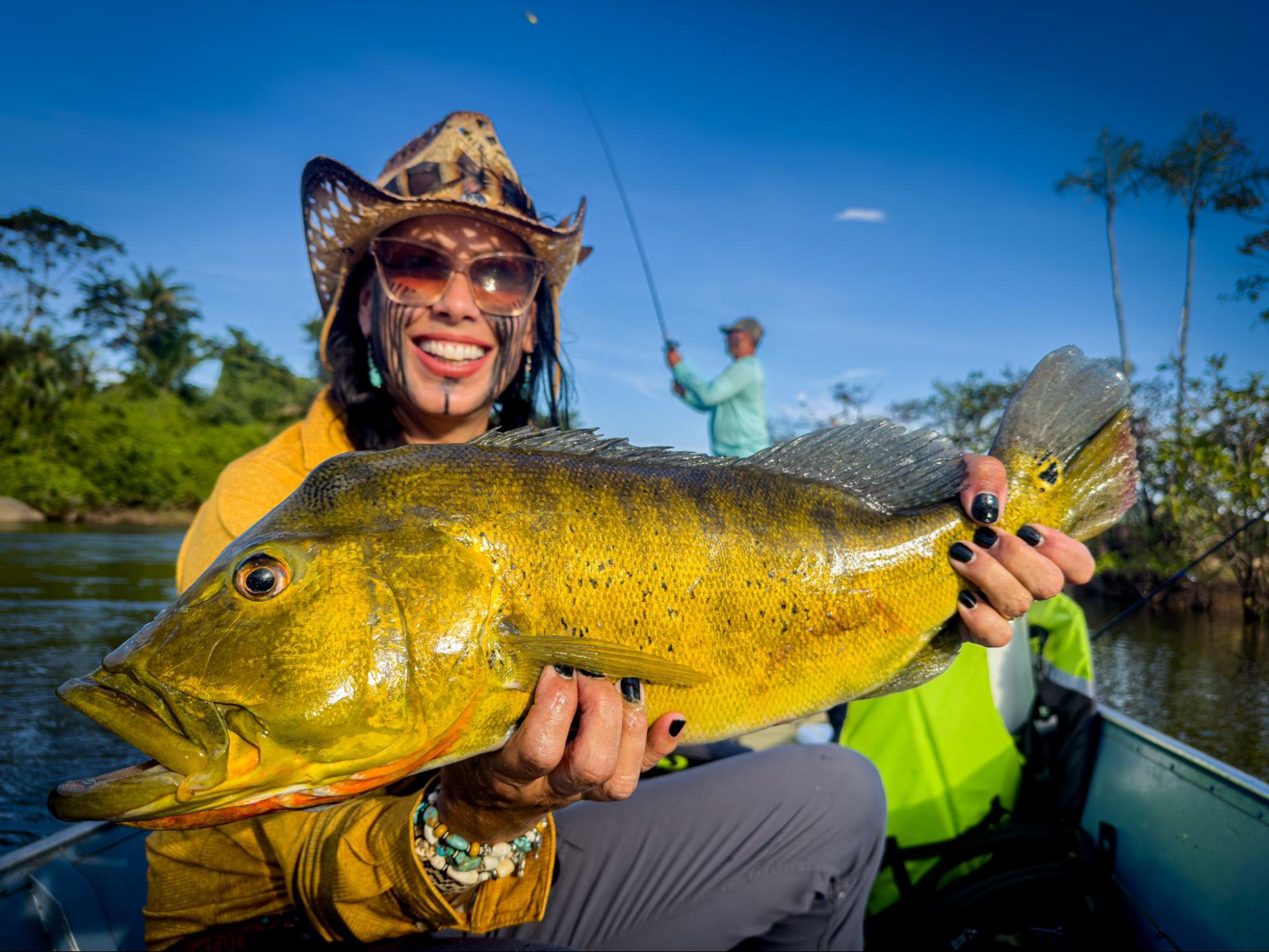
C. melaniae is native to the Xingu River Basin in Brazil. It’s easily recognized by its narrow vertical bars and scattered ocellated spots. Body coloration is golden with a bluish tint to the fins, especially in spawning fish.
These mid-sized fighters typically range from 3–8 lbs and are known for hitting crankbaits and jointed lures. Their unique appearance and fierce energy make them a standout on peacock bass adventures into less-traveled regions of the Amazon.
Cichla pinima
Popular Names: Pinima Peacock

C. pinima features a blockier shape than C. temensis, with three broken vertical bars, cheek markings, and speckled rows of white spots on juveniles. Found in clearwater rivers and along woody shorelines, these fish aggressively smash topwater and subsurface baits.

Though they rarely match the record peacock bass in size, specimens over 20 lbs have been reported. Pinima are strong fighters and a memorable catch on any South America peacock bass fishing adventure.
The Experience of Catching a Giant Peacock Bass
There’s nothing quite like the moment a giant peacock bass explodes on your lure. And if you’re lucky it will be a trophy peacock bass over 20 pounds. Photograph it, admire its beauty, and then release it gently. That flash of power as it swims away is a memory that stays with you forever.
When you return to your yacht, lodge, or floating bungalow, the stories begin. Go ahead and embellish a little—your fishing partners probably will too. Whether you're chasing the next peacock bass world record or simply reliving the thrill of landing a big peacock bass, one thing is certain: the Amazon delivers.
Other Species in the Amazon
While peacock bass are the primary focus of several of our trips, the Amazon hosts an incredible diversity of species that can be found on our multi-species destinations. Depending on the region, anglers may also hook into Amazon river catfish, including the massive piraiba (goliath catfish) and hard-fighting pirarara (redtail catfish), as well as matrinchão, pacú, pirapitinga, jacundá, traíra, apapá, tambaqui, arapaima (pirarucú), bicuda, piranha, aruanã, sorubim, trairão (wolfish), and pescada.
There are dozens of species that display unique physical beauty, impressive size, and fierce fighting capabilities. For those seeking the ultimate variety, our peacock bass fishing trips offer the opportunity to explore the full range of fish peacock bass and more on an unforgettable fishing in Brazil adventure.
Now join us on a peacock bass fishing adventure!
📧 (866) 832-2987

(866) 832-2987

